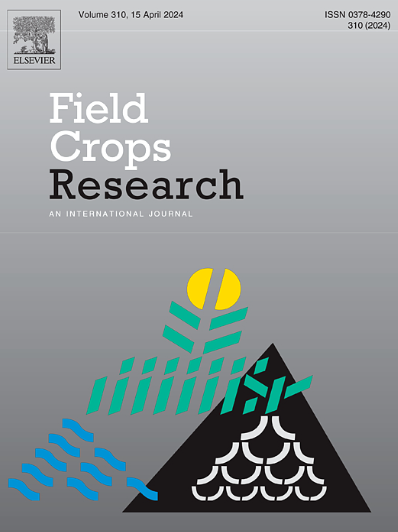合理密植条件下的轻度水分亏缺,通过协调源库关系,保证玉米产量,提高水分利用效率
IF 5.6
1区 农林科学
Q1 AGRONOMY
引用次数: 0
摘要
尽管密集种植和调控亏缺灌溉(RDI)在干旱区节水稳产方面具有一定的效果,但其产量形成的潜在机制,特别是源库关系的研究仍不充分。目的探讨不同种植密度和RDI对玉米源库特性的影响,以确定产量限制因素。目的是寻找适合西北干旱区节水稳产的玉米种植模式。方法在2020年和2021年玉米生长季,采用2种种植密度(7万株/ha (D1)和9万株/ha (D2))和3种水分处理(充分灌溉(W1)、轻度亏水(W2)和中度亏水(W3)),进行为期2年的田间试验。结果在相同水分胁迫程度下,叶面积持续时间随种植密度的增加而增加。与D1相比,W1和W2处理下D2密度下干物质积累量分别增加了10-20 %和13-20 %。大多数处理的源汇差异为正,表明在满足总汇增长后,总源供给仍有盈余。在D2密度下,只有D2W2处理两年内源库差异均为正,且其值最小。2020年和2021年D2W2处理的源汇比分别为1.08和1.02。与D2W1相比,D2W2单产略低(2-3 %),但水分利用效率和灌溉水利用效率分别提高了12-14 %和13-17 %。结论与意义高密度(D2)条件下施加的弱水分胁迫(W2)能有效调节源库平衡,但不改变汇容量不足对产量的限制作用。D2W2处理在小幅降低单产的同时,显著提高了水分利用效率和灌溉水利用效率,有效地发挥了调节亏缺灌溉的作用。本文章由计算机程序翻译,如有差异,请以英文原文为准。
Mild water deficit under reasonable dense planting ensures maize yield and improves water use efficiency by coordinating source-sink relationship
Context
Despite the effectiveness of dense planting and regulated deficit irrigation (RDI) in conserving water and stabilizing yields in arid regions, the underlying mechanisms of yield formation, specifically the source-sink relationship are still inadequately researched.
Objective
This study seeks to explore the impact of varying planting densities and RDI on maize source-sink characteristics to identify yield-limiting factors. The goal is to finding a suitable maize planting model for water conservation and stable yields in arid regions of northwest China.
Methods
A two-year field experiment was conducted during the maize growing seasons of 2020 and 2021, with two planting density (70,000 plants/ha (D1) and 90,000 plants/ha (D2)) and three water treatments (full irrigation (W1), mild water deficit (W2) and moderate water deficit (W3)).
Results
Under the same degree of water stress, leaf area duration increased with the increase of planting density. The dry matter accumulation at D2 density increased by 10–20 % and 13–20 % under W1 and W2 treatments, respectively, compared to D1. The source-sink differences were positive for most treatments, indicating that total source supply still had a surplus after fulfilling total sink growth. At D2 density, only the D2W2 treatment had a positive source-sink difference in both years, it had the smallest value. The source-sink ratio of D2W2 treatment was 1.08 and 1.02 in 2020 and 2021, respectively. Compared to D2W1, the yield per unit area of D2W2 was slightly lower (2–3 %), but water use efficiency and irrigation water use efficiency increased by 12–14 % and 13–17 % respectively.
Conclusions and implications
Mild water stress (W2) applied at high density (D2) effectively regulated the source-sink balance without altering the limiting effect of insufficient sink capacity on yield. While slightly reducing yield per unit area, the D2W2 treatment significantly improved water use efficiency and irrigation water use efficiency and effectively served as a form of regulated deficit irrigation.
求助全文
通过发布文献求助,成功后即可免费获取论文全文。
去求助
来源期刊

Field Crops Research
农林科学-农艺学
CiteScore
9.60
自引率
12.10%
发文量
307
审稿时长
46 days
期刊介绍:
Field Crops Research is an international journal publishing scientific articles on:
√ experimental and modelling research at field, farm and landscape levels
on temperate and tropical crops and cropping systems,
with a focus on crop ecology and physiology, agronomy, and plant genetics and breeding.
 求助内容:
求助内容: 应助结果提醒方式:
应助结果提醒方式:


